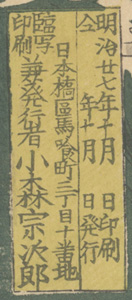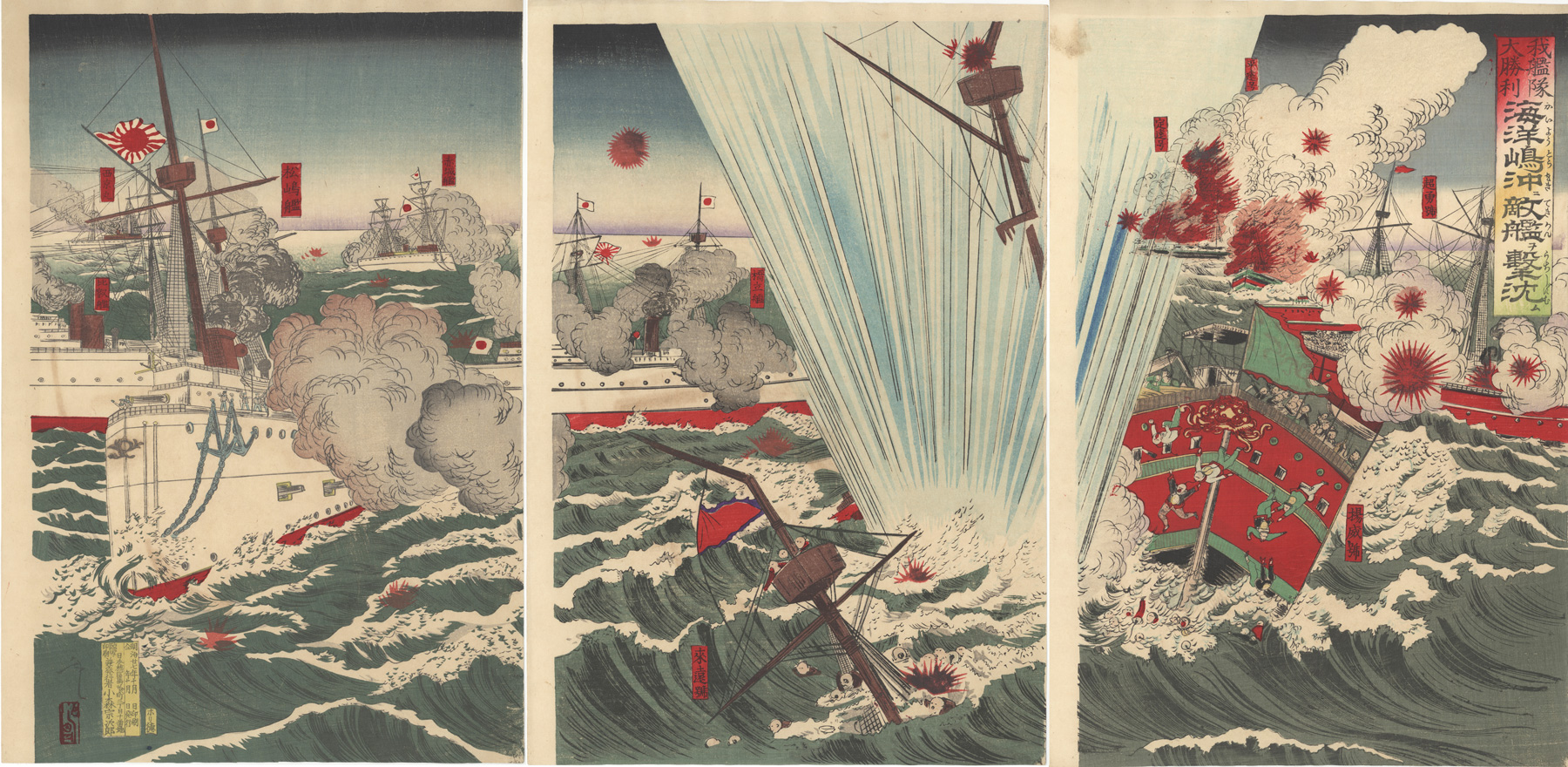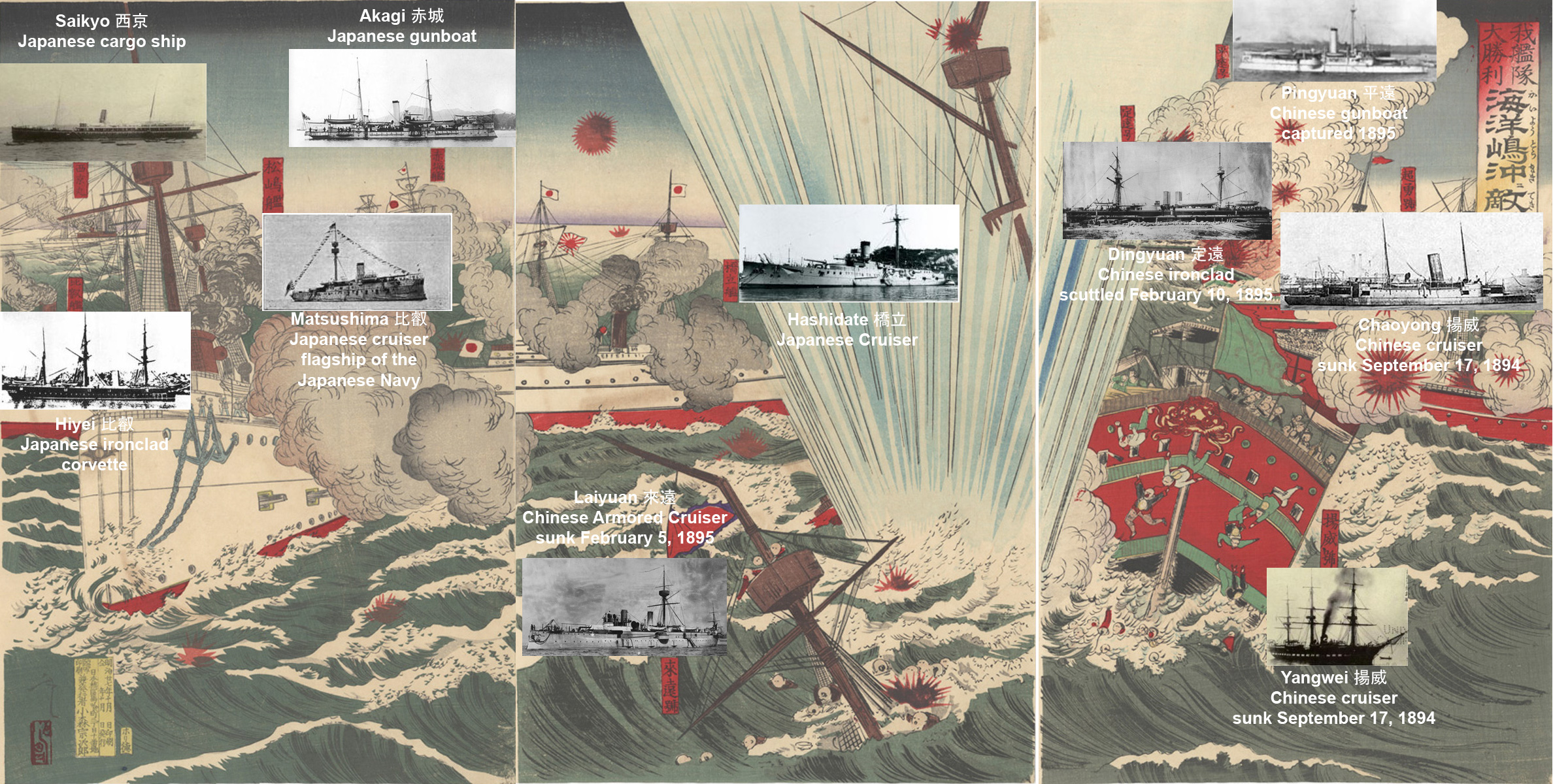About This Print
On the morning of the 17th, the two [Japanese] squadronsarrived at Haiyang; and as no Chinese warship was to be seen about the island,the squadrons made for Talu Island, off of Takushan. At 1 1:40 a.m., theChinese fleet came into sight and was advancing towards them. The Akagi and the Saikyo, not being fighting ships, were ordered to get under coverof the squadrons. At noon, just before the battle was commenced, the Japanese fleet was 12 miles tothe N.E. by N. of Talu Island. The Flying Squadron, consisting of the Yoshino,Takachiho, Naniwa, and Akitsushima, first advanced to attack the Chinese right, followed by the Main Squadron, which comprised the Matsushima, Itsukushima, Hashidate, Chiyoda, Fuso, and Hiyei. The Chinese fleet consisted ofthe Ting-yuen [Dingyuan] andChen-yuen in the centre, followed on either side and a little to the rear bythe King-yuen and Chih-yuen, outside them the Lai-yuen [Laiyuan] and Ching-yuen, then the Yang-wei and Tsi-yuen flanking them, and outermost of all theChao-yung and Kwang-chia. The Kwang-ping and Ping-yuen [Pingyuan] remainedoutside the line. At 12:45, the Chinese opened fire at 6,000 metres, but theFlying Squadron did not reply until it was within 3,000 metres. The two vesselson the extreme right of the Chinese Squadron, which were the Chao-yung [Chaoyong] and Yang-weiwere attacked by the squadron, being the nearest to it, and they were separatedfrom the fleet. The Flying Squadron continued to attack them until it was 1,600metres from them. The Chao-yung [Chaoyong] caught fire and sank. As the Main Squadron advanced at the rate of ten knots an hour,the Hiyei, which could not keep upthat speed, was soon left behind, followed closely by the Fuso; and when theChinese saw the Hiyei laggingbehind, the Ting-yuen [Dingyuan] and Ping-yuen[Pingyuan] poured broadsides into her; but these two assailants were tooclose together and had to desist from firing for fear of hitting each other.The Hiyei, finding herself at suchclose quarters, boldly advanced between the Ting-yuen [Dingyuan] andKing-yuen and passing through the Chinese line, rejoined the Main Squadron. Twotorpedoes were discharged at her, but missed their mark; a shell, however, fromthe Ting-yuen's [Dingyuan] great gun struck her ward-room and worked a great havoc.At 1:55 she caught fire and was hors de combat, though the fire wassubsequently extinguished.
The gun-boat Akagihad also been left behind. The vessels of the Chinese left wing pressed upon herand though her starboard guns cleared the Lai-yuen's[Laiyuan] bridge of men, her own bridgesuffered no less. Her captain, Commander Sakamoto, was killed as well asseveral of her gunners. Her mainmast was also struck down, and she was hotly pursued by the Lai-yuen [Laiyuan] and others, and she only escaped by causing a fire on theLai-yuen's [Laiyuan] quarter-deck, whereuponthe Lai-yuen [Laiyuan] and the rest sloweddown to extinguish it. The Akagi'ssteam-pipe was damaged, but was afterwards repaired.
The Saikyo, on seeingthe Chih-yuen and Kwang-ping approach her, had got under cover of the Flying Squadron; but when the latter went to the rescue of the Hiyei and Akagi, she wasonce more exposed; and four shells from the Ting-yuen's [Dingyuan] greatgun struck the upper deck saloon, shattered the woodwork, and damaged the steering-gear.The Matsushima and the Ping-yuen [Pingyuan] next exchanged shots.The former's wardroom was damaged and four men were killed, while the latter's 26cm. gun was disabled. The Ping-yuen [Pingyuan], Kwang-ping, and a torpedo boatnext assailed the Saikyo; two torpedoeswere discharged at her, but she managed to steer clear of them. She was afterthis out of action, as she had suffered severe though not vital injuries. A duelbetween the two hostile flagships resulted in the Chinese catching fire and theJapanese losing the use of three 12 cm. guns, and the death or disablement of over60 men, on the latter through a heap of ammunition catching fire. The latter's 32cm. gun was temporarily damaged. Her hull also listed slightly. The Chinese flagshipwas ably covered during the fire by her sistership Chen-yuen. By this time the Yang-wei and the Chih-yuen had been sunk.The Tsi-yuen had fled, followed by the Kwang-chia, which struck the Tsi-yuen andwas stranded near Talienwan. The flying Squadron pursued the remaining ships. The Lai-yuen [Laiyuan] again caughtfire but managed to return to Port Arthur, almost a wreck, while her sister-shipKing-yuen was sunk by the Yoshino.
Thus the Chinese lost five men-of-war, namely, the Chaoyang, Yang-wei, Chih-yuen, King-yuen,and Kwang-chia, while the Japanese lost none at all, the greatest damages havingbeen suffered by the Matsushima, Akagi, Hiyei,and Saikyo, all of which were soon refitted for service.
Print Details
| IHL Catalog | #1357 |
| Title or Description | A Great Victory of Our Fleet: An Enemy Ship was Attacked and Sunk on the Open Sea off of Haiyang Island 我艦隊大勝利 海洋嶋沖ニ敵艦ヲ撃沈ム Waga kantai daishori: Kaiyoto oki ni tekikan o uchishizumu |
| Artist | Utagawa (Shunsai) Toshimasa (1866-1913) |
| Signature |  |
| Seal | 年昌 Toshimasa (see above) |
| Publication Date | October 1894 (Meiji 27) (see publisher's seal below) |
| Publisher |  |
| Carver |  |
| Impression | excellent |
| Colors | excellent |
| Condition | excellent |
| Genre | ukiyo-e; senso-e (Sino-Japanese War) |
| Miscellaneous | |
| Format | vertical oban triptych |
| H x W Paper | 14 11/16 x 9 15/16 in. (37.3 x 25.2 cm) approx. each sheet |
| H x W Image | 14 3/16 x 9 3/8 in. (36 x 23.8 cm) approx. for each sheet |
| Literature | |
| Collections This Print | The Walters Art Museum 95.688 |



